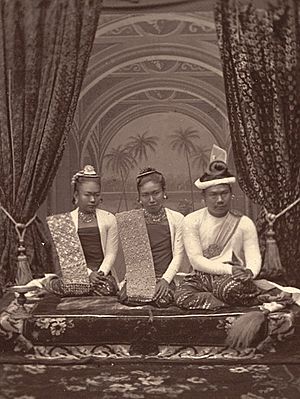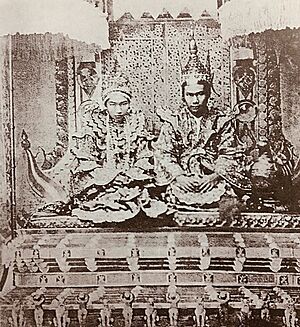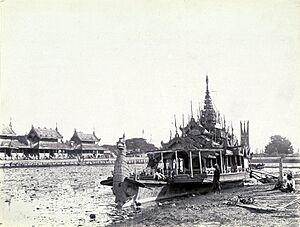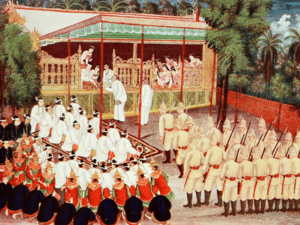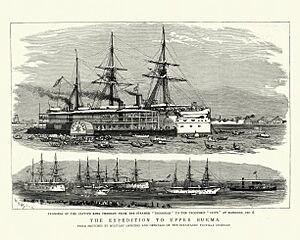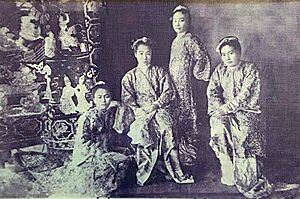Thibaw Min facts for kids
Quick facts for kids Thibawသီပေါမင်း |
|||||
|---|---|---|---|---|---|
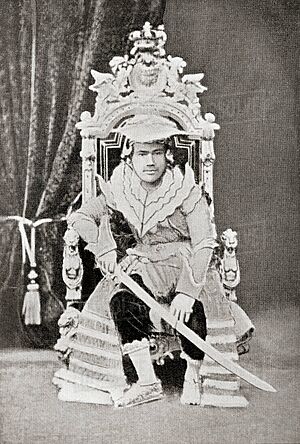
Thibaw, c. 1880
|
|||||
| King of Burma Prince of Thibaw |
|||||
| Reign | 1 October 1878 – 30 November 1885 | ||||
| Coronation | 6 November 1878 | ||||
| Predecessor | Mindon Min | ||||
| Successor | Empire abolished (Victoria as Empress of India) |
||||
| Prime Minister | Kinwun Mingyi U Kaung | ||||
| Born | Maung Yay Set (မောင်ရေစက်) 1 January 1859 Saturday, 12th waning of Nadaw 1220 ME Mandalay, Konbaung Burma |
||||
| Died | 19 December 1916 (aged 57) Tuesday, 10th waning of Nadaw 1278 ME Ratnagiri, Bombay State, British India |
||||
| Burial | Ratnagiri, India | ||||
| Spouse | Supayagyi Supayalat Supayalay |
||||
| Issue Detail |
2 sons, 4 daughters, including: Myat Phaya Gyi Myat Phaya Lat Myat Phaya Myat Phaya Galay |
||||
|
|||||
| House | Konbaung | ||||
| Father | Mindon Min | ||||
| Mother | Laungshe Mibaya | ||||
| Religion | Theravada Buddhism | ||||
| Signature | |||||
King Thibaw (born January 1, 1859 – died December 19, 1916) was the last king of the Konbaung dynasty in Burma (now Myanmar). He was also the very last monarch in the country's long history. His time as king ended when the Royal Burmese armed forces lost to the British Empire in the Third Anglo-Burmese War. This happened on November 29, 1885. Burma officially became part of the British Empire on January 1, 1886.
Contents
Early Life of King Thibaw
Prince Thibaw was born with the name Maung Yay Set. His father was King Mindon, and his mother was one of the king's wives, Laungshe Mibaya. Thibaw's mother was sent away from the palace by King Mindon. She spent her last years as a thilashin, which is a type of female Buddhist renunciant in Burma.
When he was young, Thibaw studied Buddhist texts at a kyaung (a monastery school). He did this to gain his father's approval. He passed important religious exams called Pahtamabyan. This earned him respect from his father and the chief queen. He also went to school at Aitchison College in Lahore, which is now in Pakistan.
One of King Mindon's main wives, Queen Hsinbyumashin, helped arrange a marriage. She wanted her oldest daughter, Supayagyi, to marry Thibaw. They were half-siblings, meaning they shared the same father.
Becoming King: Thibaw's Accession
In 1878, Thibaw became king after his father's death. This period involved many changes in the royal family. Hsinbyumashin, one of Mindon's queens, became very powerful in the palace. She made sure that Thibaw and her daughter Supayagyi would become king and queen.
During the coronation ceremony, Supayalat, another daughter, joined her sister. She insisted on being crowned queen at the same time. This was very unusual and had never happened before in Burma's history. So, two queens were crowned together.
When Thibaw became king, Lower Burma was already under British control. This was about half of the kingdom's land. King Thibaw wanted to get this land back. Relations with the British became difficult in the early 1880s. The king seemed to be getting closer to the French government.
Things got worse because of an event called "The Great Shoe Question." British visitors refused to take off their shoes before entering the royal palace. This was against local custom, so they were sent away.
At this time, the kingdom's money was running low. The government had to make peasants pay more taxes. In 1878, a national lottery was started to try and raise money. It became popular, but many families lost their savings. The lottery was stopped in 1880.
In late 1878, a meeting at Mandalay Palace changed the government. The Hluttaw (the king's council) grew from four departments to 14. These new departments covered many areas, like farming, public works, and foreign affairs.
King Thibaw also created a new way to organize the country. He divided the kingdom into 10 districts, similar to how British India was run. Each district had a minister in charge. This helped to centralize control from the palace.
In 1885, King Thibaw's court announced that they wanted to take back Lower Burma. The British used this as a reason to invade. They said the king was breaking agreements. A large British force, led by General Harry Prendergast, invaded Burma. It included 11,000 soldiers and many boats.
King Thibaw's Abdication
British troops quickly reached Mandalay, the royal capital. There was not much resistance. Within a day, the troops marched to the Mandalay Palace. They demanded that King Thibaw and his kingdom surrender completely within 24 hours. At that time, the king and queen were resting in a summer house in the palace gardens.
The next morning, King Thibaw and his family were forced onto a bullock cart. They then went to a steamer boat on the Irrawaddy River. A large crowd of people watched them leave.
Life in Exile
After giving up his throne, Thibaw, his wife Supayalat, and their two young daughters were sent away by the British. They had to move to Ratnagiri, British India. This was a port city by the Arabian Sea.
For their first 24 years in India, Thibaw's family lived in a place called Outram Hall. In 1906, the government built a new, larger home for them. It was a grand two-story brick building, often called "Thibaw's Palace." It was set in 20 acres of gardens.
The British government gave Thibaw money each year. He was known for staying mostly on his property in Ratnagiri. However, he did support local festivals, especially during Diwali. King Thibaw died on December 15, 1916, at age 57. He was buried in a small plot next to a Christian cemetery.
Royal Family's Return to Burma
After King Thibaw's death, the remaining royal family members were allowed to move back to Burma in 1919. The king's oldest daughter, Myat Phaya Gyi, had a daughter named Tutu. Despite family disagreement, Myat Phaya Gyi and Tutu returned to Ratnagiri. They lived there for the rest of their lives. They faced financial difficulties and made paper flowers to sell. Tutu also lived in poverty and had eleven children. These children knew little about their royal background until recently.
The second daughter, Myat Phaya Lat, became a claimant to the throne. She married her father's private secretary, Khin Maung Lat, who was also her nephew. They did not have children of their own. However, Lat adopted her Nepalese maidservant's son.
The third daughter, Myat Phaya, married twice. Her first husband was a Burmese prince, Hteik Tin Kodawgyi. They had a daughter named Phaya Rita. After they divorced, she married a Burmese lawyer, Mya U. Phaya Rita later married her cousin, Taw Phaya. He was a younger son of Myat Phaya Galay.
The fourth daughter, Myat Phaya Galay (1887–1936), married a former Burmese monk, Ko Ko Naing. They had six children. Their oldest son, Taw Phaya Gyi (1922–1948), became a claimant to the throne. His son Soe Win is the current claimant. Another son, Taw Phaya, married his cousin, Phaya Rita.
Both the third and fourth daughters were born in India but died in Burma. Two of their children married each other. This helped to continue the royal family line.
A Secret Affair
King Thibaw had a secret love affair with a noblewoman named Daing Khin Khin. This happened when his queen, Supayalat, was not around. The king's friend, Maung Maung Toke, helped arrange this. To marry Daing Khin Khin, King Thibaw promised to keep her safe in the palace. He also promised to give her the royal title of the Queen of the Northern Palace. He swore that if he broke this promise, he would lose his throne. Sadly, the king did not keep his promise, and this caused serious problems for Daing Khin Khin.
Renewed Interest in King Thibaw
In December 2012, the president of Burma, Thein Sein, visited King Thibaw's tomb in Ratnagiri. He also met the king's descendants. He was the first leader of the Burmese government to visit the grave. He also visited the former royal palace in Ratnagiri.
Family Life
- Parents:
- Mindon Min
- Laungshe Mibaya
- Wives and children:
- Supayalat
- Myat Phaya Gyi
- Myat Phaya Lat
- Myat Phaya
- Myat Phaya Galay
- 2 sons (names not known)
- Supayagyi
- Supayalay (junior queen)
Links
|
Thibaw Min
Born: 1 January 1859 Died: 19 December 1916 |
||
| Regnal titles | ||
|---|---|---|
| Preceded by Mindon |
King of Burma 1 October 1878 – 29 November 1885 |
Succeeded by Burmese monarchy abolished |
| Royal titles | ||
| Preceded by Kanaung |
Heir to the Burmese Throne as Prince of Thibaw 19 September 1878 – 1 October 1878 |
Succeeded by Myat Phaya (Presumed) |


